I firmly believe that a daily schedule for disabled dogs can improve their health. I’m also certain that a good routine is the number one reason pet owners succeed in taking care of paralyzed animal.
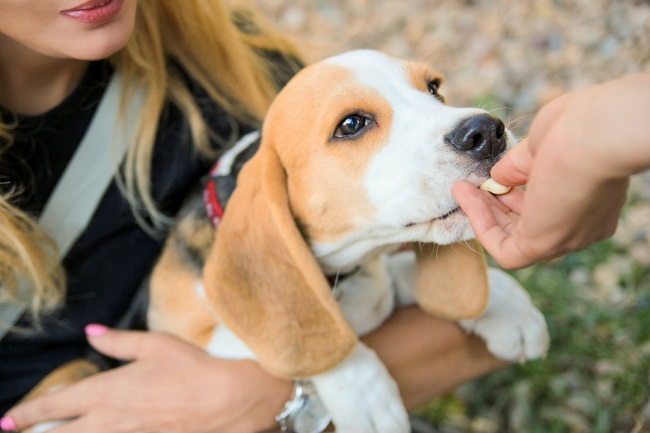
You might think these statements sound a little dramatic, but over the years I’ve heard from a lot of pet parents who are overwhelmed at the idea of caring for their recently disabled pup.
But once we breakdown each task into small segments, pet moms and dads realize that life can be manageable. In fact, many of them write to me a month or two later with suggestions about streamlining my process.
Note: Talk with your veterinarian before changing your dog’s current routine.
How a daily schedule for a disabled dog works
Dogs need to feel safe and secure, especially after a scary health problem that’s left them unable to walk. Sharing a routine with the people who love them, helps our pets adjust to their new circumstances. It teaches a dog that they can count on us, no matter what happens in the future.
A good schedule meets your pet’s physical, emotional and social needs. Here’s how to break it all down.
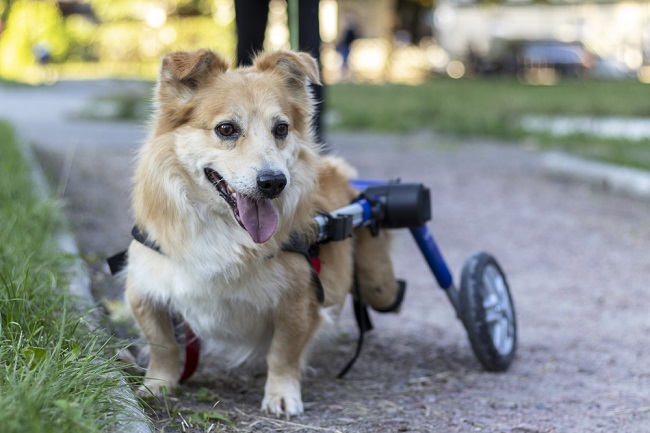
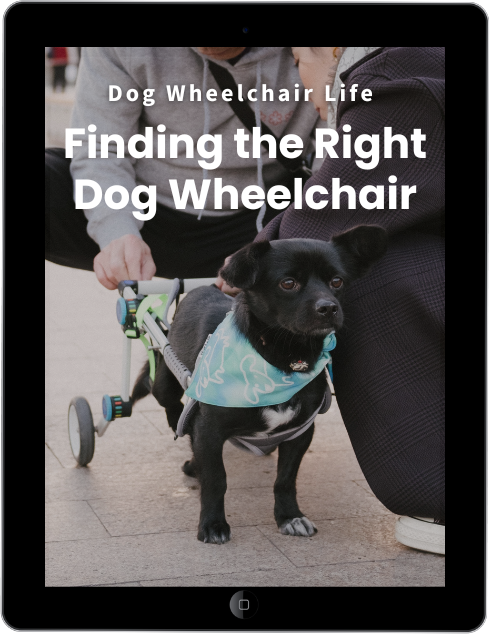
eBook
Find The Right Dog Wheelchair For Your Pet
Your dog has a mobility problem, and you want to buy a wheelchair. But do you know what kind of cart will work best for your dog’s individual needs? After a decade of teaching pet owners how to make the right choice, I put the information into an eBook!
Physical health
On a calendar, list your dog’s daily medications and when they need to be administered. Then add to it, veterinary appointments and rehab treatments. Make sure you also schedule time for the therapies you’ll be doing at home. These can include: light therapy, pain management, physical therapy and more.
Next schedule your calendar for meals, potty breaks, walks and playtime. It also helps to pencil-in a daily bath. Paralyzed dogs get dirty easily from scooting to get around. In addition, most dogs with paralysis are also incontinent. So, while you’re learning how your dog handles these new situations, plan for more baths than usual.
Another health concern for disabled dogs is being prone to pressure sores. It happens when they lie on a hard surface for an extended period of time. If your dog can’t flip his body over, schedule time every couple of hours to turn him to the opposite side.
Emotional well-being
Routine helps your pet feel secure. It reduces stress and promotes emotional stability. If possible, stick to the same schedule every day, especially during the first few weeks.
If you have to change the routine or if you have to be away from home, consider having a professional pet sitter, neighbor or a relative stay with your dog. Even a short visit will make a disabled dog feel safe.
Working pet parents can leave a favorite toy or a long-lasting treat to provide emotional support while they’re away. As long as your pet is in a safe place in your home like a small room or an X-pen or a child’s playpen, being away from home can work well, as long as you’re consistent with the plan.
Bathroom needs
The majority of dogs with mobility problems are also incontinent. That means their bladders need to be manually expressed or they wear diapers. Whichever method you choose, you’ll need to schedule into your routine, 3-5 times a day for potty breaks.
Sticking to a strict bathroom schedule is good for your dog’s overall health. It minimizes urinary tract infections, and it stops dogs from having urine scald – a problem that develops when a dog sits too long in a soiled diaper.
The schedule I used to express my dog Sophie, looked like this: Potty break when she woke up, a second expressing after lunch, a third after dinner and a final bathroom break before bed.
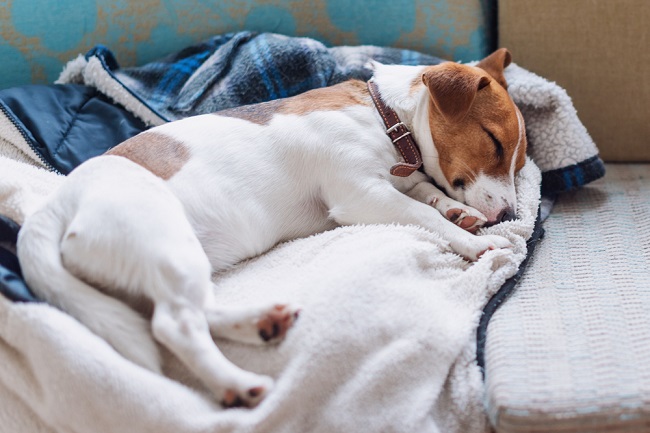
Feeding schedule
Regular feeding times help regulate a dog’s digestion. It also ensures that your pet is receiving the proper amount of nutrition and hydration. Paralyzed dogs who scoot on the ground or use wheelchairs tend to use up more calories and need more water than able-bodied dogs. Regular meals alleviate this problem and having multiple water bowls around the house will keep them well-hydrated.

Get the Essential Guide
The Essential Guide of Products for Handicapped Dogs e-book is a labor of love for me. I wrote it to answer your most pressing questions about where to find the best products for your wheelchair dog. You’ll find products you didn’t know existed and each will improve your dog’s quality of life. Print a copy and keep it by your side.
Exercise and dog wheelchairs
Depending on the diagnosis, your dog might need specific exercises or a dog wheelchair. Incorporating physical therapy or a walk in a cart into a daily routine helps maintain muscle strength, joint mobility and overall physical health. Schedule time on your calendar for daily exercise.
Social interaction and playtime
Scheduled time to be with family members and other pets prevents your dog from feeling isolated and lonely. Daily playtime is important for a dog’s emotional well-being.
Sophie had two dog housemates who each took turns playing a sit-down version of tug-of-war with her. The three of them also sat side-by-side to enjoy dog bones and dog puzzles. You’ll be surprised how well a paralyzed dog can adapt at playing some of these modified games.
Rehabilitation
If your pet is undergoing physical therapy, hydrotherapy or another form of rehab, be sure to add those times to the daily schedule. It will improve your attendance in class and help you reinforce the skills you learn, at home. Going through rehab is time consuming, but it’s key to improving your dog’s health and recovery.
Predictability
Knowing what to expect at certain times of the day reduces stress for you and your dog. It makes caregiving more efficient and helps you address your pet’s needs immediately.

My favorite harnesses for disabled dogs.
Sleep
Scheduling time to sleep is also vital for you and for your dog. Feeling rested from a good night’s sleep contributes to the overall health for both of you.
Bonding and trust
A routine increases the bond between a pet parent and a dog. It teaches dogs that they can rely on their person for their care and to keep them safe and loved.
On the flip side, please keep in mind that schedules need some flexibility. There will be times when adjustments are necessary, and that’s normal and okay. Change them up as needed and get back to the original routine when it’s possible.
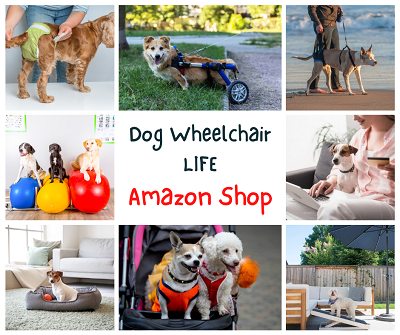


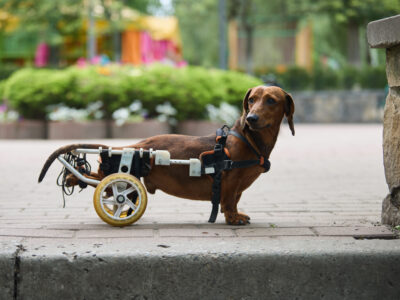
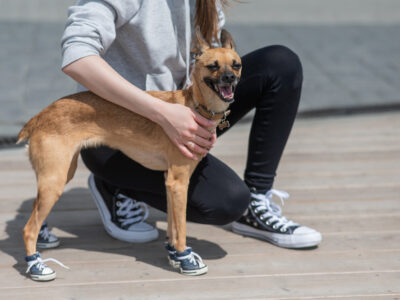

Leave a Reply